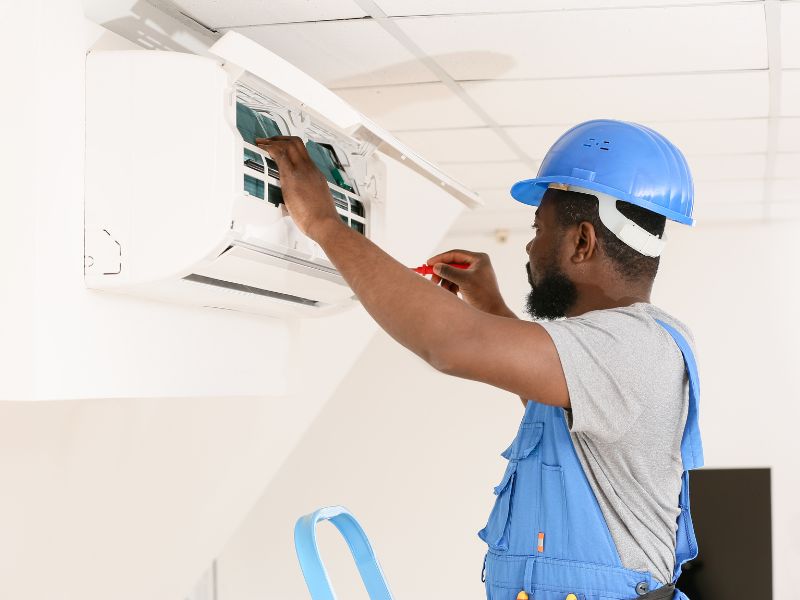If you’re an AC owner, chances are you have come across the issue of a full drip pan. This not only poses a threat to the proper functioning of your cooling system, but it can also lead to water damage to your house. Now, the question remains: how much water should be in the AC drip pan? In this article, we’ll delve into the factors that affect the amount of water in the pan, and how to prevent overflow and water damage. So, let’s get started!
Tabe of Contents
- 1. The Importance of Monitoring Water Levels in Your AC Drip Pan
- How Much Water Should Be in AC Drip Pan?
- 2. Signs of Overfilling or Underfilling in Your AC Drip Pan
- 3. Understanding Your AC’s Water Usage and Drainage System
- 4. Tips for Maintaining the Optimum Water Level in Your AC Drip Pan
- 5. Frequently Asked Questions About AC Drip Pan Water Levels
- People Also Ask
- Conclusion
1. The Importance of Monitoring Water Levels in Your AC Drip Pan
How Much Water Should Be in AC Drip Pan?
It’s important to keep track of the water levels in your AC drip pan to prevent any damage or malfunctions to your air conditioning system. The drip pan collects the condensation from your AC unit and if the water level gets too high or too low it can cause problems.
If the water level is too high, it can overflow and damage your floors or furniture. It can also lead to mold growth or even cause the system to shut down. On the other hand, if the water level is too low, it means your AC system is not functioning properly and can cause damage to the compressor or other components of your air conditioning system.
Monitoring the water levels in your AC drip pan should be part of your regular maintenance routine. It can prevent costly repairs and increase the lifespan of your AC unit.
One tip to monitor your AC drip pan is to check it regularly for any signs of water buildup or leakage. Another is to set up an alarm or sensor that alerts you when the water level reaches a certain point. Whatever method you use, it’s important to keep track of the water levels to ensure that your AC unit is functioning properly.
2. Signs of Overfilling or Underfilling in Your AC Drip Pan
Monitoring water levels in the AC drip pan is crucial to ensure the proper functioning and efficiency of your HVAC system. An overfilled or underfilled drip pan can lead to various problems, including leaks, blockages, and damage to your air conditioning system. Below are some signs to look out for to determine if your AC drip pan is overfilled or underfilled:
Signs of Overfilling :
– Wet spots on the floor around the air handler unit.
– Water dripping or flowing from the air handler unit.
– Musty or moldy odors from the AC system.
– Ice forming on the evaporator coils.
Overfilling of the drip pan can be caused by a clogged condensate drain, a broken condensate pump, or simply not ensuring the proper water levels in the drip pan.
TIP: Regularly inspect the condensate drain line and clean it to prevent clogs.
Signs of Underfilling :
– Dry drip pan.
– Unusual noises, like gurgling or hissing from the AC system.
– Weak air conditioner performance.
Underfilling of the drip pan can be caused by low humidity levels, reduced cooling demand, or incorrect installation of the system. While an underfilled drip pan may not cause immediate damage, it can still negatively affect the performance of your air conditioning system.
TIP: Monitor the humidity levels in your home and adjust the settings on the thermostat accordingly.
Knowing the signs of an overfilled or underfilled AC drip pan can help you identify and solve problems with your HVAC system early on. Remember to regularly inspect and maintain your AC system to prevent any issues caused by an incorrect water level in the drip pan.
3. Understanding Your AC’s Water Usage and Drainage System
Understanding how your AC unit uses water and how it drains can help you maintain the appropriate water level in your AC’s drip pan. Central air conditioning systems rely on a process called refrigeration cycle to cool homes and buildings. As part of this process, the AC’s evaporator coil absorbs heat from the air, causing moisture to condense on the coils.
This moisture then drips down into the AC’s drip pan. The pan collects the water and channels it to the outside of the home or building through a drain pipe. The AC’s drainage system then ensures that the water flows away from both the building’s foundation and the AC unit itself.
When the drainage system becomes clogged or damaged, water can accumulate in the drip pan, leading to overfilling. Conversely, a shortage of water in the drip pan indicates a problem with the AC unit’s ability to produce condensation or an issue with the drainage system.
It’s important to check the drainage system and the water level in the drip pan regularly to keep your AC unit functioning efficiently and to prevent water damage to your home or building. In the next section, we will discuss some tips for maintaining the optimum water level in your AC’s drip pan.
4. Tips for Maintaining the Optimum Water Level in Your AC Drip Pan
To ensure that your AC unit runs efficiently and effectively, it’s crucial to maintain the right water level in the drip pan. In this section, we’ll provide you with some tips that can help you maintain the optimum water level in your AC drip pan.
Tip #1: Check Water Level Regularly
Checking the water level in your AC drip pan is the first step in ensuring that it remains at the optimum level. You should check the water level once a week, especially during the summer months when your air conditioning unit is working harder. If you notice that the water level is too high or too low, take immediate action to correct it to avoid any damage or inefficiency.
Tip #2: Clean Your AC Regularly
Dirt, debris, and mold can accumulate in your AC unit, causing a blockage in the drainage system. When this happens, the water from the condenser coil collects in the drip pan and overflows. To prevent this from happening, ensure that you clean your AC unit regularly. You can use a soft-bristled brush and a mild detergent to clean the coil and the drip pan, and ensure there are no blockages in the drainage system.
Tip #3: Install a Float Switch
A float switch is a device that is installed in the drip pan and designed to shut off the AC unit when the water in the drip pan reaches a certain level. Installing a float switch can help prevent overfilling of the drip pan, which can damage your AC unit and cause water leaks. A professional HVAC technician can install a float switch for you.
By following these tips, you can maintain the optimum water level in your AC drip pan and ensure that your AC unit operates efficiently and effectively. Remember to have your AC unit regularly serviced by a professional HVAC technician to prevent any issues that can arise from an improperly maintained unit.
5. Frequently Asked Questions About AC Drip Pan Water Levels
In this section, we will answer some frequently asked questions regarding AC drip pan water levels.
How often should I check the water level in my AC drip pan?
It is recommended to check the water level in your AC drip pan at least once a month. However, if you live in an area with high humidity or have pets in your home, it is best to check it more frequently.
What should I do if my AC drip pan is overfilled?
If your AC drip pan is overfilled, it can cause water damage to your home, which can be expensive to repair. To avoid this, turn off your AC system immediately and drain the water from the pan. You can use a wet/dry vacuum or a hose to remove the water. After that, find the cause of overfilling and fix the issue.
Can underfilling of AC drip pan cause any issue?
Yes, underfilling of AC drip pan can cause issues such as dry air, low cooling efficiency, and increased wear and tear on your AC system. To prevent underfilling, ensure that your AC unit has enough refrigerant and that the drainage system is functioning correctly. You can also add a few cups of water manually to maintain the optimum water level.
Should I clean my AC drip pan?
Yes, you should clean your AC drip pan at least once a year or as needed. Cleaning the pan helps to prevent the growth of mold, bacteria, and other harmful organisms, which can affect your indoor air quality. To clean the pan, turn off your AC system and remove any debris or water from the pan using a wet/dry vacuum or a cloth. You can then use a mixture of soap and water to clean the pan before rinsing it thoroughly and allowing it to dry.
In conclusion, monitoring and maintaining the right water level in your AC drip pan is crucial to prevent water damage, maintain optimal cooling efficiency, and promote healthy indoor air quality. By following these tips and the frequently asked questions, you can ensure that your AC system runs smoothly and lasts longer.
People Also Ask
Why does water collect in AC drip pan?
AC drip pans collect water due to the condensation process that occurs when warm and humid air passes over the cool evaporator coils inside the air conditioning unit.
What happens if there is too much water in AC drip pan?
If there is too much water in the AC drip pan, it can overflow and damage the surrounding area. Excess water in the pan can also cause the air conditioning system to turn off or malfunction.
How often should you check your AC drip pan?
It is recommended to check the AC drip pan every 3-6 months. However, if there are noticeable signs of water leakage or the air conditioning system is not working properly, it should be checked immediately.
How do you clean an AC drip pan?
To clean an AC drip pan, first turn off the air conditioning system. Then, remove the water from the pan and clean it using a mixture of water and mild detergent. Rinse the pan thoroughly and dry it before replacing it.
Can a clogged AC drain cause water in the drip pan?
Yes, a clogged AC drain can cause water to back up into the AC drip pan. This can result in an overflow and potential damage to the surrounding area.
Conclusion
It is important to monitor the amount of water in an AC drip pan to prevent potential damage to the air conditioning system and surrounding area. Checking the pan every 3-6 months and cleaning it regularly can help prevent any issues. If there is an excess amount of water in the pan, it is recommended to contact a professional to assess and repair the system.

Bobby leads Air Conditioners Contractors with a vision for innovation and excellence in the HVAC industry. With a passion for customer satisfaction and a drive for technological advancement, he ensures the company remains at the forefront of delivering top-tier air conditioning solutions across the USA. His leadership fosters a culture of dedication, expertise, and commitment to exceeding client expectations.

